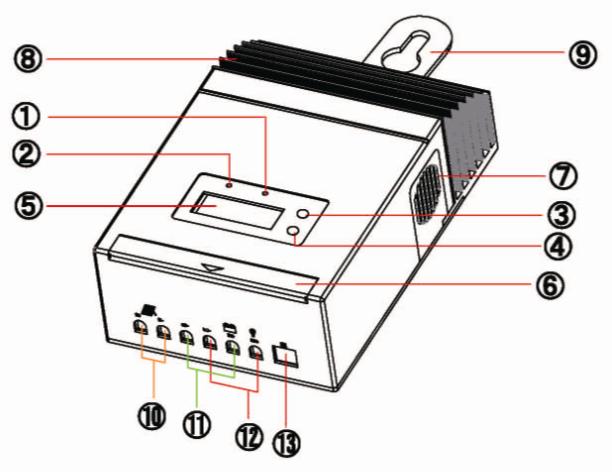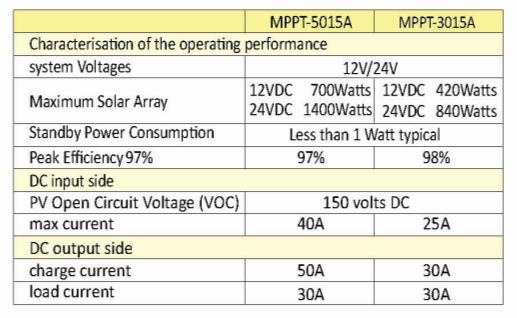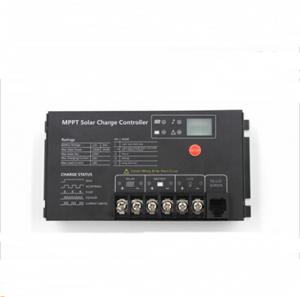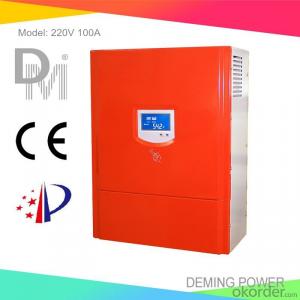SUN-MPPT-5015A Solar charge controller 50A
- Loading Port:
- Ningbo
- Payment Terms:
- TT or LC
- Min Order Qty:
- 20 pc
- Supply Capability:
- 10000 pc/month
OKorder Service Pledge
OKorder Financial Service
You Might Also Like
1. Overview
Thank you for selecting the MPPT solar charge controller.
The MPPT is essentially a smart DC to DC converter which has been optimized to harvest maximum energy from the PV array in battery based solar electric systems by using a variety of maximum power point tracking (MPPT) strategies.
The controller’s secondary objective is to ensure that the batteries receive a full charge without becoming overcharged.
This is accomplished through a four stage charging process.
Please take the time to read this operator’s manual and be familiar with the controller.
This will help you make full use of the many advantages the MPPT can provide for your PV system.
2. Features
1 - Battery Status LED Indicator:An LED indicator that shows battery status or system errors.
2 - Charging Status LED Insdicator:An LED indicator that shows charging status and overvoltage of pv.
3 - Setting Button1:Set load work mode,battery type and max charge current.
4 - Setting Button2:Set load work mode,battery type and max charge current(in manual mode used for load ON/OFF).
5 - LCD Digital Display:Dispaly the system status
6 - Wiring Box Cover:Sheet metal wiring box cover protects power connections
7 - FAN:FAN to dissipate Internal circuit heat
8 - Heatsink:Aluminum heatsink to dissipate controller heat
9 - Mounting Hanger:Keyhole slot for mounting
10 - Solar Module Terminals:Connect solar modules
11 - Battery Terminals:Connect batteries
12 - Load Terminals:Connect loads
13 - RJ45 Communication Interface:Communicate with personal computer

The mounting location is important to the performance and operating life of the controller. The environment must be dry and protected from water ingress. If required, the controller may be installed in a ventilated enclosure with sufficient air flow. Never install the MPPT unit in a sealed enclosure. The controller may be mounted in an enclosure with sealed batteries, but never with vented/ flooded batteries. Battery fumes from vented batteries will corrode and destroy the MPPT circuits. Multiple MPPT can be installed in parallel on the same battery bank to achieve higher charging current. Additional parallel controllers can also be added in the future. Each MPPT must have its own solar array.
CAUTION: Equipment Damage or Risk of Explosion
Never install the MPPT in an enclosure with vented/Flooded batteries. Battery fumes are fl ammable and will corrode and destroy the MPPT circuits.
CAUTION: Equipment Damage
When installing the MPPT in an enclosure, ensure suffi cient ventilation. Installation in a sealed enclosure will lead to over-heating and a decreased product lifetime.
NOTE : Mounting
When mounting the MPPT ,ensure free air through the controller heat sink fins. There should be at least 150mm of clearance above and below the controller to allow for cooling. If mounted in an enclosure, ventilation is highly recommended.
3. Specifications
Electrical

NOTE:

All charging voltage setpoints listed are for 12 Volt systems. Multiply 2X for 24 Volt systems.
Battery Charging Charging algorithm 4 - stage Charging stages Bulk, Absorption, Float, Equalize Temperature compensation coeffcient -5 mV / °C / cell (25 °C ref.) Temperature compensated setpoints Absorption, Float, Equalize, HVD Charging Setpoints
- Q:Can a solar controller be used with a solar panel cleaning system?
- Yes, a solar controller can be used with a solar panel cleaning system. A solar controller is responsible for regulating the power flow from the solar panels to the batteries or grid, ensuring optimal performance and protection. Using a solar controller in conjunction with a solar panel cleaning system can help monitor and control the power output, ensuring efficient cleaning operations without any potential damage to the panels.
- Q:Can a solar controller be used in a mobile solar power system, such as an RV or boat?
- Yes, a solar controller can definitely be used in a mobile solar power system such as an RV or boat. In fact, it is highly recommended to use a solar controller in these setups to regulate and optimize the charging of the batteries. The solar controller helps prevent overcharging, protects the batteries from damage, and ensures efficient power generation from the solar panels.
- Q:What is the load current rating of a solar controller?
- The load current rating of a solar controller refers to the maximum amount of current it can safely handle when supplying power to connected loads, such as lights or appliances. The specific rating can vary depending on the model and specifications of the solar controller.
- Q:What is the role of a battery equalization function in a solar controller?
- The role of a battery equalization function in a solar controller is to balance the charge levels of individual battery cells or groups of cells within a battery bank. This function ensures that each cell or group is charged and discharged evenly, preventing any imbalances that can lead to reduced battery performance or premature failure. By equalizing the charge levels, the battery's overall capacity and lifespan are optimized, resulting in more efficient and reliable energy storage for the solar system.
- Q:How do you prevent over-discharging of batteries with a solar controller?
- One way to prevent over-discharging of batteries with a solar controller is by using a controller with a built-in low-voltage disconnect (LVD) feature. This feature automatically disconnects the load from the battery when its voltage drops to a predetermined level, protecting the battery from being over-discharged. Additionally, properly sizing the solar controller and battery bank according to the load's power requirements helps ensure that the battery is not drained beyond its safe operating limits.
- Q:Can a solar controller be used with solar panels of different brands?
- Yes, a solar controller can be used with solar panels of different brands as long as they have compatible specifications and voltage ratings. The solar controller's function is to regulate the charging of batteries or the power output from the solar panels, regardless of the brand. However, it is recommended to ensure compatibility and consult the manufacturer's guidelines for optimal performance.
- Q:How does a solar controller handle different charging stages?
- A solar controller handles different charging stages by monitoring the voltage and current levels from the solar panels and the battery. It adjusts the charging process accordingly, starting with the bulk charging stage where it delivers maximum current to rapidly charge the battery. Once the battery reaches a certain voltage threshold, it switches to the absorption stage, where it maintains a constant voltage to ensure the battery is fully charged. Finally, it enters the float stage, where it provides a lower voltage to keep the battery topped off without overcharging it. The solar controller intelligently manages these stages to optimize the charging process and prolong the battery's lifespan.
- Q:How do you prevent battery over-temperature with a solar controller?
- One way to prevent battery over-temperature with a solar controller is by implementing temperature sensors or probes that monitor the battery's temperature. The solar controller can be programmed to adjust the charging parameters, such as the charge current or voltage, based on the temperature readings. This allows for a controlled and efficient charging process, preventing the battery from overheating and potentially damaging its performance or lifespan.
- Q:Can a solar controller be used with a solar-powered telecommunications system?
- Yes, a solar controller can be used with a solar-powered telecommunications system. A solar controller helps regulate the flow of electricity from the solar panels to the batteries, ensuring that the system is charged efficiently and protecting the batteries from overcharging. It is an essential component in maintaining the performance and longevity of a solar-powered telecommunications system.
- Q:How does a solar controller handle battery overvoltage protection?
- A solar controller handles battery overvoltage protection by monitoring the voltage level of the battery. When the voltage exceeds a certain threshold, the controller activates a protection mechanism to prevent further charging. This can include reducing or stopping the flow of current from the solar panels to the battery, thereby preventing overcharging and potential damage to the battery.
1. Manufacturer Overview |
|
|---|---|
| Location | |
| Year Established | |
| Annual Output Value | |
| Main Markets | |
| Company Certifications | |
2. Manufacturer Certificates |
|
|---|---|
| a) Certification Name | |
| Range | |
| Reference | |
| Validity Period | |
3. Manufacturer Capability |
|
|---|---|
| a)Trade Capacity | |
| Nearest Port | |
| Export Percentage | |
| No.of Employees in Trade Department | |
| Language Spoken: | |
| b)Factory Information | |
| Factory Size: | |
| No. of Production Lines | |
| Contract Manufacturing | |
| Product Price Range | |
Send your message to us
SUN-MPPT-5015A Solar charge controller 50A
- Loading Port:
- Ningbo
- Payment Terms:
- TT or LC
- Min Order Qty:
- 20 pc
- Supply Capability:
- 10000 pc/month
OKorder Service Pledge
OKorder Financial Service
Similar products
New products
Hot products
Hot Searches
Related keywords
























